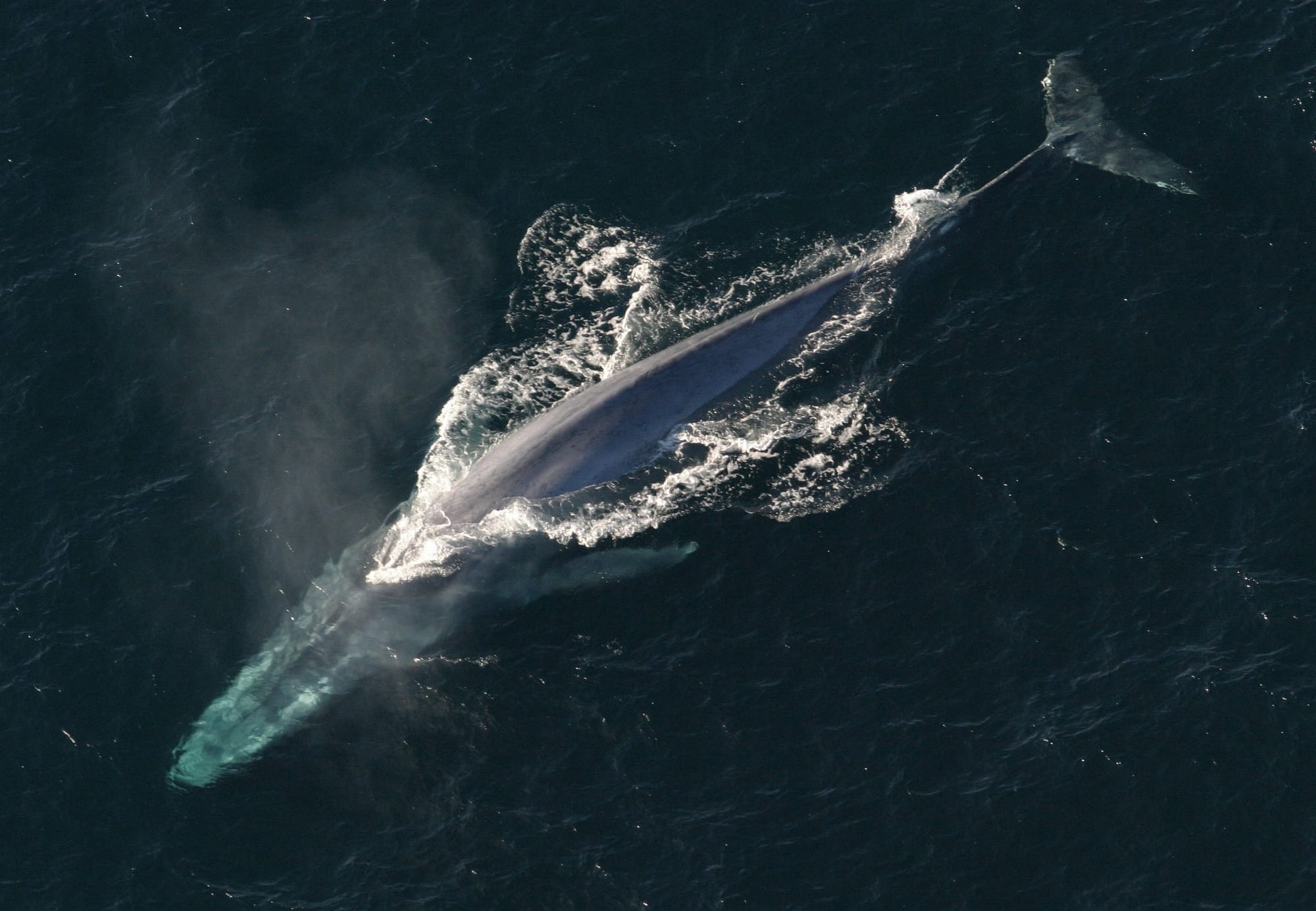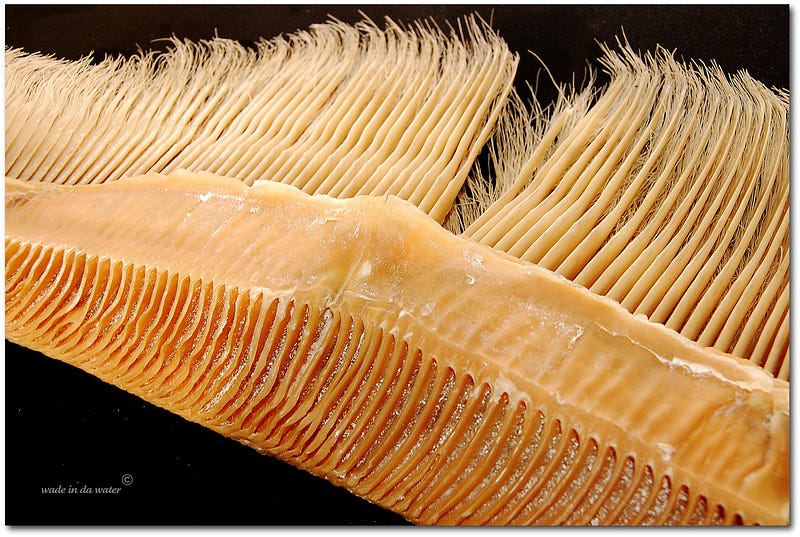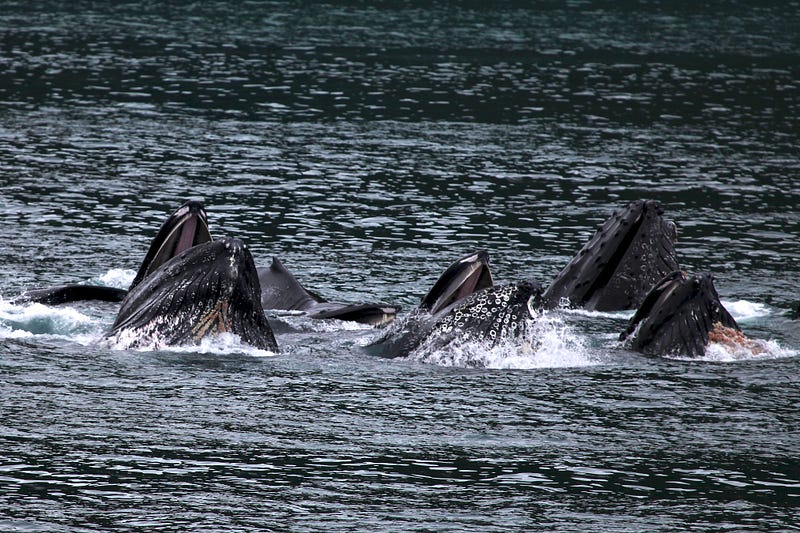
Sometimes, it might seem like having to forage for food can be such a bother. Wouldn’t it be nice if the food came to you? Or even better, if you simply ate while traveling because the very act of moving brought food to you? At first glance, it might seem like this is the case for one particular group of organisms: the baleen whales.
This is a group of 15 species of marine mammals of enormous size. Even the smallest species, the pygmy right whale, Caperea marginata, is at least 6 meters long. At 30 meters in length, the blue whale above, Balaenoptera musculus, is the largest known animal. This group also includes one of the most well know marine mammals, the humpback whale, Megaptera novaeangliae. All 15 species are filter feeders, they pick out small prey items like krill, zooplankton, and small fish by filtering ocean water through a structure common to all of them: baleen.

Baleen is attached to a whale’s upper jaw in plates. If you look at the above picture and think, ‘that looks a bit like hair’, you have a good eye because it is a bit like hair. Baleen is not made from bone like mammalian teeth, but from a substance called keratin. Keratin is a filamentous protein-chain structure that can be found in hair, nails, claws, horns, and hooves as well as reptile scales and bird feathers and beaks. The baleen looks similar to a comb and works on a similar principle. Water passes through the mouth and prey items become stuck on the filaments.
Unfortunately, being a filter feeder isn’t as carefree an existence as it might first appear. For one thing, foraging still takes energy and it actually isn’t worth it unless the prey concentration is high enough. Rather than simply eating on the go, baleen whales still need to find prey pockets to make foraging worthwhile and energy efficient.
This is especially true for the lunge-feeding whales. While some baleen whales will skim-feed, swim with their mouth open to capture prey, over half of the species have a much more active foraging strategy. They inflate their mouth to expand its size and then lunge into a large collection of prey. In order for this technique to be worth the energy and time required, high prey concentration is important. However, the whales do not simply rely on the prey to congregate on their own. Instead, they create a concentrated baitball that they can then lunge at and devour. Humpback whales have developed a particularly efficient method, pictured below, called ‘bubble net’ feeding.

Humpbacks are migratory and breed in tropical areas where food is scarcer. During that time, they rely on their fat reserves and do not feed. However, in the high latitudes, prey density increases, allowing the bubble net technique to work (this is true for both terrestrial and marine habitats, moving towards the equator species diversity increases and abundance decreases while diversity continues to decline and abundance is increased as you move farther north or south). The whales work in a group to encircle their prey by blowing bubbles in a ring. Some individuals will attempt to herd the prey to the surface from below. Others will disorient them with vocalizations as the remaining whales prevent escape by creating an ever shrinking circle of bubbles. When the group is ready, they expand their mouths and lunge upward to capture as much prey as possible, trusting the baleen to filter it from the water.
This particular feeding behavior is not instinctual, but rather is learned. Not all humpback populations know how and so some do not perform it at all and instead are more solitary foragers. However, being able to bubble net is highly adaptive as studies have shown that foraging efficiency for lunge-feeding increases dramatically at higher prey density.
However, this makes it quite clear that, as the title of this story say, there is no free lunch in the natural world. Even marine filter feeders must expend energy in order to acquire food, and must be selective about when to do so and what techniques to use so as to maximize efficiency, and thus increase survival. And yes, Finding Nemo notwithstanding, some baleen whales do eat fish (usually small ones like herring because they have no teeth and have to be able to swallow them whole).
I hope you are enjoying Season 5 so far. There are so many wondrous and varied diets and foraging strategies found in the natural world, we’ve barely scratched the surface yet. As always, let me know what you like about my stories and what sorts of topics you’d want to see me cover in the future. Also, please share these with anyone else you think might enjoy them.